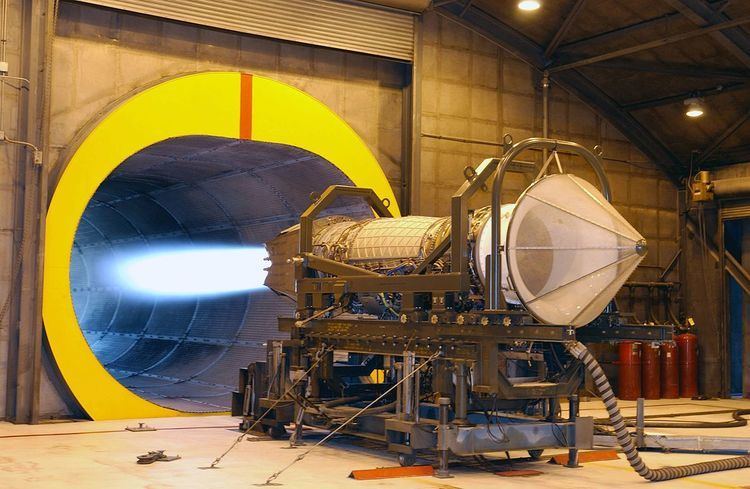 | ||
The Pratt & Whitney F119 (company designation PW5000) is an afterburning turbofan engine developed by Pratt & Whitney for the Lockheed Martin F-22 Raptor advanced tactical fighter.
Contents
The engine delivers thrust in the 35,000 lbf (160 kN) class, and is designed for supersonic flight without the use of afterburner (supercruise). Delivering almost 22% more thrust with 40% fewer parts than conventional, fourth-generation military aircraft engine models, the F119 allows sustained supercruise speeds of up to Mach 1.8. The F119's nozzles incorporate 2D thrust vectoring technology. These nozzles direct the engine thrust ±20° in the pitch axis to give the F-22 enhanced maneuverability.
The F119 derivative, the F135, produces 40,000 lbf (180 kN) of thrust for the Lockheed Martin F-35 Lightning II.
History
The F119 resulted from the Joint Advanced Fighter Engine (JAFE) program in the early 1980s aimed at supplying the powerplant for the Air Force's Advanced Tactical Fighter (ATF). Detailed design of Pratt & Whitney's submission, designated internally as PW5000, began when the JAFE request for proposals (RFP) was released in May 1983. Advances in engine technology, such as those from the Integrated High Performance Turbine Engine Technology (IHPTET) program, allowed the design to do more work with fewer stages, with the PW5000 having only 6 compressor stages compared to the F100's 10 compressor stages. The high pressure and low pressure turbines were single stage and counter-rotating, thus shortening the engine and saving weight. The fan and compressor stages were to use integrally bladed rotors (IBR) to reduce weight and cost and improve performance. The combustor, designated Floatwall, eliminates welds to mitigate crack growth due to thermal cycling. This technology allows the engine to achieve very high core temperatures to meet the requirement for high specific thrust for supercruising. The original RFP called for maximum thrust in the 30,000 lbf class.
Pratt & Whitney and General Electric were selected to make prototype engines, designated YF119 and YF120 respectively, for demonstration and validation. The ATF's increasing weight required more thrust to meet the performance requirements, and required max thrust increased by 20% to 35,000 lbf class. Pratt & Whitney's design changed to incorporate a 15% larger fan, increasing bypass ratio from 0.25 to 0.30. However, the larger fan was not test flown on the ATF flight demonstrators to avoid potential reliability issues that may arise. Instead, the revised fan was extensively ground tested at Wright-Patterson Air Force Base. As a result, both the YF-22 and YF-23 had lower performance with the YF119s compared to the YF120s.
On 3 August 1991, Pratt & Whitney was awarded the EMD contract for ATF engine, while the Lockheed/Boeing/General Dynamics team won the contract for the ATF airframe. While the YF119 was a more conventional design compared to the General Electric's variable cycle YF120, Pratt & Whitney accrued far greater test hours and emphasized the lower risk. The production F119-PW-100 was fitted on the F-22 Raptor.
In 2013 Pratt assisted the F119 Heavy Maintenance Center (HMC) at Tinker Air Force Base, Oklahoma in the first depot overhaul of a F119 engine.
